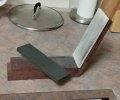I became more and more interested in kitchen knives at the beginning of this year. I already have two Victorinox Fibrox, but I was unable to make them sharp for more than 1 week. I tried pull through sharpener that was advised to me in local knife shop and whetstones. Both of them gave mediocre results regarding both edge retentions and sharpness. Of course my whetstone skills are horrible. 
I thought that maybe the knives themselves were a problem and bought $250 SG2 Gyuto knife and $100 VG10 pairing knife. I didn't even try to sharpen them myself using whetstones, I got them professionally sharpened in the Japanese knife shop that I bought them in (stellar google reviews). They're both beautiful, can get very sharp and can stay sharp longer, but... they can do it for 2-3 weeks. In the meantime, I bought Worksharp Precision Adjust system but was a little hesitant to use them on my expensive Japanese Knives given the short clamp and not good stability. I sharpened some of my other knives, and the results were really good, but it takes a long time and they stayed sharp for only two weeks. I even bought after magnetic blade holder attachment, but I'm still waiting for it to be shipped to me.
In the end, I'm around 400$ poorer, and my initial issues were not resolved.
I can appreciate the craftsmanship of the knife, they look beautiful, but in the end I need a tool. A cutting tool and sharpening tool. I lost hope to get expensive knife that will just stay sharp and need sharpening only every 6 months-1 year. Worksharp PA is cool and all, but it takes ~15 min per knife, every 2-3 weeks, which quickly adds up with multiple knives. I know that there are other fixed angle systems out there, but the time investment is still there.
Is there a fast and easy way I can sharpen these beautiful expensive knives without ruining them? Worksharp Ken Onion? Or should I rather sell my expensive knives and abuse Victorinoxes with an electric sharpener?
I thought that maybe the knives themselves were a problem and bought $250 SG2 Gyuto knife and $100 VG10 pairing knife. I didn't even try to sharpen them myself using whetstones, I got them professionally sharpened in the Japanese knife shop that I bought them in (stellar google reviews). They're both beautiful, can get very sharp and can stay sharp longer, but... they can do it for 2-3 weeks. In the meantime, I bought Worksharp Precision Adjust system but was a little hesitant to use them on my expensive Japanese Knives given the short clamp and not good stability. I sharpened some of my other knives, and the results were really good, but it takes a long time and they stayed sharp for only two weeks. I even bought after magnetic blade holder attachment, but I'm still waiting for it to be shipped to me.
In the end, I'm around 400$ poorer, and my initial issues were not resolved.
I can appreciate the craftsmanship of the knife, they look beautiful, but in the end I need a tool. A cutting tool and sharpening tool. I lost hope to get expensive knife that will just stay sharp and need sharpening only every 6 months-1 year. Worksharp PA is cool and all, but it takes ~15 min per knife, every 2-3 weeks, which quickly adds up with multiple knives. I know that there are other fixed angle systems out there, but the time investment is still there.
Is there a fast and easy way I can sharpen these beautiful expensive knives without ruining them? Worksharp Ken Onion? Or should I rather sell my expensive knives and abuse Victorinoxes with an electric sharpener?

